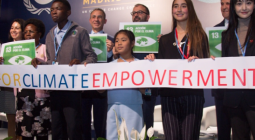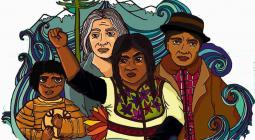COP25: Self-serving G20 spites youth, humanity, world at climate talks.
- With 500,000 mostly young climate activists rallying in Madrid streets, COP25 delegates agreed to disagree on nearly everything, with smaller nations striving to pave the way for implementation of a strong Paris Agreement at COP26 in 2020, while G20 nations dragged their feet, obfuscated, and stopped forward progress.
- The climate conference failed to increase national Paris Agreement carbon reduction pledges, likely dooming the world to catastrophic temperature increases above 2 degrees Celsius (3.6 degrees Fahrenheit) by 2100 unless dramatic advances are implemented next year at COP26 in Glasgow, Scotland.
- The G20 and corporate allies kept the closing of carbon accounting loopholes off the agenda: tree plantations will be counted as forests; the burning of wood pellets (as carbon-polluting as coal) will be counted as carbon neutral; and tropical dams now known to produce major methane releases, will be counted as zero carbon sources.
- The U.S., blocked already promised “loss and damage” financial pledges made to the developing world. Double counting of emissions wasn’t banned. No carbon market mechanism was approved. Paris Agreement language assuring “human rights, the right to health, [and] rights of indigenous peoples” was stripped from COP25 official documents.
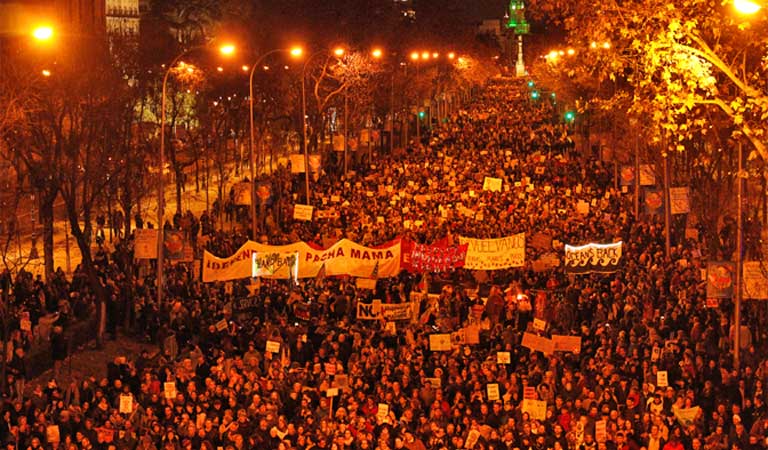
MADRID, Spain – The leaders of the world’s 20 largest economies appeared to agree on one thing at the 25th annual United Nations climate summit (COP25) here in Spain’s capital. They would definitely not heed the call of the world’s youth who protested relentlessly, led by 16-year-old Swedish activist Greta Thunberg, demanding a future for themselves and the planet.
In what observers are calling a stunning failure of the UN climate process, those leaders would also not agree to up their Paris Agreement carbon-reduction pledges. They would not commit the billions they promised to poor nations struggling with escalating heat, drought and deluge. They would not consider human rights a moral duty as they maneuvered to devise carbon markets enriching themselves and corporations.
And they would do virtually nothing to curb earth-heating emissions — while stonewalling against all efforts to close carbon accounting loopholes that will make the planet even hotter.
It was the longest-ever COP, or Conference of the Parties, with nature signaling herclimate-changed wrath in every corner of the globe. But those with the power to act chose — after two weeks of tortured, fruitless negotiations — to do next to nothing, while the world burns.
“How long will you keep negotiating?” an angry Hilda Flavia Nakabuye, a 22-year-old activist from Uganda traveling with Thunberg, scolded ministers last week. “You’ve been negotiating for the last 25 years, even before I was born. Do you want Africa to perish before you act? Please listen: if you don’t know how to fix it, stop breaking it.”
Expectations were already low heading into COP25. But with Brazil, Australia, Saudi Arabia and the United States throwing bombs, little came of the conference aside from a few technical items to complete a mixed results Paris rulebook. For what it’s worth, the Paris Agreement will go into force in 2020, even as the United States, the world’s second biggest carbon polluter, becomes the only nation to exit the global accord.
“The Paris Agreement may have been the victim of a hit and run by a handful of powerful carbon economies,” said Jennifer Morgan, executive director of Greenpeace International, “but they are on the wrong side of this struggle, the wrong side of history, and the Paris Agreement is just one piece of the puzzle. We need systemic change that people can trust.”

Little to trust at COP25 on action items
The list of blocked and failed COP25 initiatives is both long and demoralizing:
- Ambition: Although the world’s major emitters were never expectedto announce significant new climate pledges at COP25, there was some hope they might collectively send a strong message of intent for next year. They did not. Brazil and China, the world’s biggest polluter, argued against doing anything other than “revisiting” reductions pledges made in Paris in 2015. Talk of halting accelerating global deforestation wasn’t even on the agenda, and was rarely discussed, though it remains a major Paris priority. Without strong forest conservation policies, scientists agree the 2oC limit is beyond reach.
- Reneging on pre-2020 pledges: Developing countries have long been angered that rich countries haven’t lived up to the climate action they promised by 2020. China, India and others refused to support strong language on raising ambition without a call for wealthy countries to provide the finance and support previously promised to developing countries. The U.S. led those refusing to make any commitment of financial aid, even though its Paris agreement withdrawal may mean it never has to.
- Loss and damage: There have long been calls by vulnerable nations and civil society for new streams of finance in compensation for “loss and damage” — the term for climate impacts that cannot be adapted to. In 2015, a fund of $100 billion was promised by 2020. Little has been raised. A work group was formed to take up the issue again next year. Vulnerable nations were appalled at another work group and no funds.
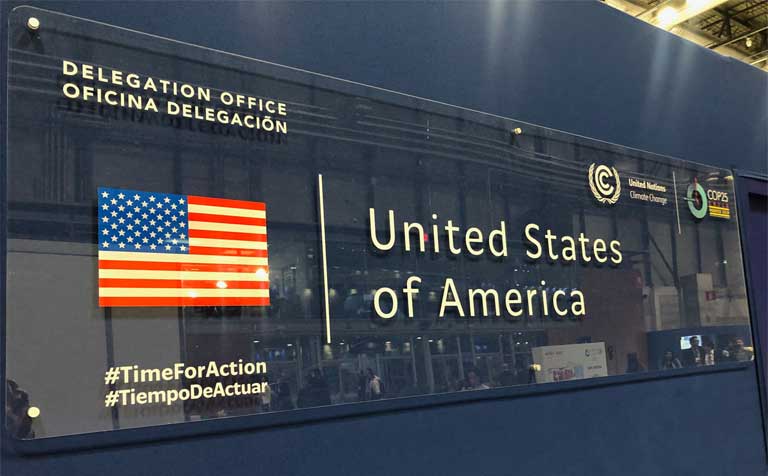
- Article 6: This was the highest-profile COP25 agenda item, creating a mechanism by which to establish carbon markets and providing a monetary incentive for nations to step up their carbon-reduction ambition. Critics feared the worst; they were right to do so. Fossil fuel companies lobbied G20 nations in the run-up to COP25 to make sure their interests led the talks. Nations such as Brazil (abundant rainforests for sale), Australia (abundant coal to burn) and Saudi Arabia (abundant oil, also to burn) made clear that any sincere climate change-mitigation goals would be diminished. Ultimately, the European Union, under enormous pressure from smaller countries, kept Article 6 from being completed in Madrid — heeding warnings that no deal would be better than a deal that undermined Paris.
- Double counting: Even as dire UN scientific reports stressed the urgency of drastically and quickly reducing emissions to avoid the worst impacts of climate change after 2030, some nations sought policy loopholes to avoid reductions, while still get credit for doing so — carbon cuts existing on paper, as the sky fills up with greenhouse gases. The Paris Agreement is clear that a country that sells emissions cuts via offsetting credits to another country cannot count those emissions reductions towards its own climate targets. But though nearly all countries agree with this fiat, Brazil argued that this so-called “corresponding adjustment” is not needed initially. Cheating, critics pointed out, does not fool nature. The issue was left unresolved, with negotiators agreeing to return to it at COP26 in Glasgow, Scotland, when they take a third crack at completing Article 6.
- Kyoto carryover credits: This is a close cousin to double counting, perpetuating past policy loopholes and allowing known cheating on emissions counting. The new system under Paris would allow emission-reduction credits to be traded on an open carbon market. However, some nations, including Australia, Brazil and India, want to be able to use old, unspent credits in the new system. Critics rightfully fear that such allowances would flood the market with cheap credits that do not represent real emissions reductions, thus rendering the entire system a fraud. Australia openly plans to use Kyoto carryover credits to reduce its Paris emissions-reduction pledge by nearly 50 percent — without actually reducing. The UN text on carryover credits remains vague, leaving the door open for their approval — unless leadership emerges in 2020 to block the move.
- Human rights: In its preamble, the original Paris Agreement makes clear that “parties should, when taking action to address climate change, respect, promote and consider their respective obligations to human rights, the right to health, the rights of indigenous peoples…” In one of the bigger reversals outraging activists at COP25, Brazil, Australia and Saudi Arabia had human rights language stripped from Article 6 in defense of national sovereignty. It remains out of the text, but developing nations and civil society have pledged a brutal fight at COP26 to restore not only the language, but an honest commitment to human rights in climate policy.
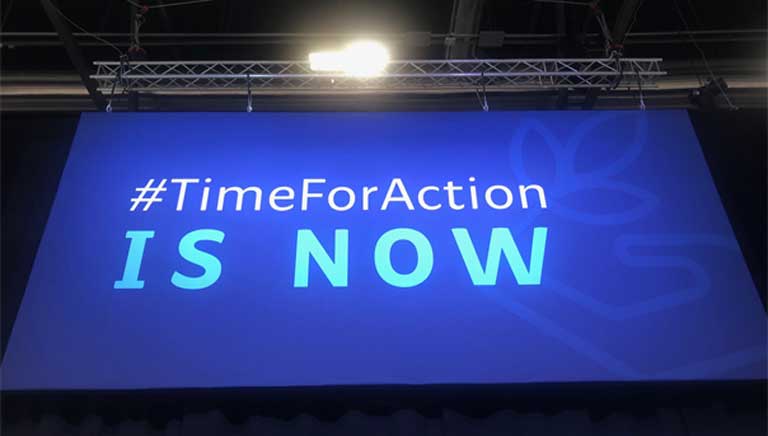
How did we get here?
Some veteran climate summit attendees view COP25 as a cynical continuance of a quarter-century of past performance, with rich industrial nations ignoring the realities of rapidly surging global heating they’ve largely caused, while feigning good faith in a corrupt process.
But that overlooks an important historical fact — the aggressive leadership of U.S. President Barack Obama during his last two years in office, when his re-election was no longer an issue. Obama bewildered environmentalists by promoting renewable energy and better vehicle fuel-economy standards, while allowing more fracking and oil exploration. Still, many analysts agree he craved an environmental legacy and saw the pathway to Paris as the answer.
At COP20 in Lima, Peru, in 2014, Obama and U.S. Secretary of State John Kerry achieved a breakthrough, persuading China to support a voluntary global emissions reduction plan to be signed in Paris at COP21 in 2015. China, long a resister, agreed. The rest of the world fell in line and the Paris Agreement was drafted in Lima.
U.S. leadership under Obama was greatly enhanced by two towering figures in international climate policy — UN General Secretary Ban Ki-moon of South Korea and Christina Figueres of Costa Rica, the executive secretary of the UN Framework Committee on Climate Change (UNFCCC). Together, these respected leaders wielded the clout needed to push past laggards and to force G20 delegates to listen to the grievances of vulnerable nations at Paris.
One example of their contribution: the initial Paris goal was to hold global temperature rise to 2 degrees Celsius (3.6 degrees Fahrenheit) by 2100 over a 1900 baseline (temperatures have risen 1oC (1.8oF since 1900). But low-lying Pacific nations argued that 2 degrees would wipe them off the map; the goal must be 1.5 degrees or they would not sign. Pushed by Ban and Figueres, the U.S. reluctantly agreed; China and other industrialized nations came onboard.
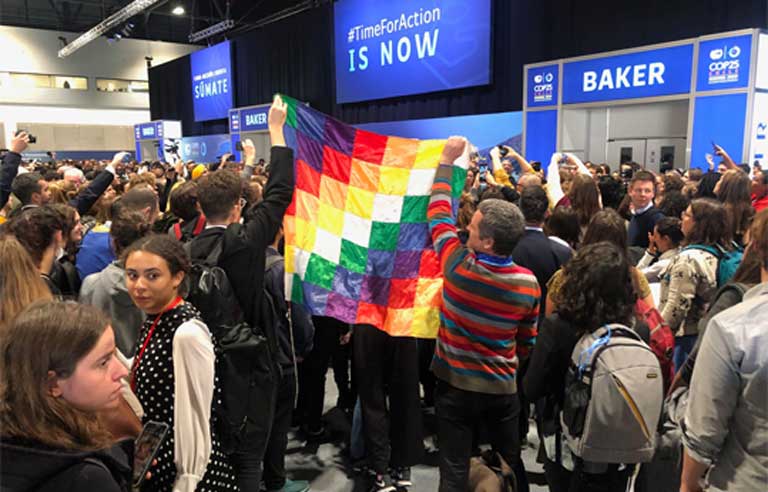
Trading Obama for Trump
COP21 and the Paris Agreement, though relying on voluntary compliance and international cooperation, was supposed to be a starting point toward meaningful emission reductions; but it turned out to be a high-water mark in climate negotiations. Whatever hope it created was dashed 11 months later when Donald Trump was elected U.S. president in November 2016, just as COP22 was starting in Marrakesh, Morocco. Negotiators there were stunned.
From the first, the question in Marrakesh became: who will step up to lead in the fulfillment of Paris? At the same time, Ban and Figueres were stepping down; successors Antonio Guterres of Portugal and Patricia Espinosa of Mexico have not been nearly as influential or effective since taking over.
The leadership answer was fully revealed in Madrid. It was not to be China, the world’s largest carbon polluter. Nor was it the EU, which is pre-occupied with Brexit, an increasingly climate-driven immigration crisis and the rise of nationalism.
Brazil, Australia and Saudi Arabia stepped into the vacuum instead, not to carry the spirit or framework of Paris forward, but each with a strong economic interest to undermine the global accord. At COP25, their delegates stood firm against overwhelming climate science evidence, disregarded the climate impacts each is feeling at home, and stayed deaf to the resounding pleas of a global youth movement led by Thunberg.
Emboldened by the negative U.S. influence under Trump, these nations showed no interest in acknowledging the existential threat to life on earth posed by their actions.
Unless US leadership reemerges after the presidential election next November, none of this bodes well for COP26 in Scotland and the final negotiations that will launch the Paris Agreement in 2020 — potentially sealing the fate of humanity and the planet.
Justin Catanoso, a professor of journalism at Wake Forest University in North Carolina, covers climate change and climate policy for Mongabay; this was his sixth UN climate summit. Follow him on Twitter @jcatanoso
Banner image caption: Two empty chairs on the set of a COP25 broadcast outlet seemed to symbolize the failing ambition and lack of integrity on display at the Madrid summit. Image by Justin Catanoso.
FEEDBACK: Use this form to send a message to the author of this post. If you want to post a public comment, you can do that at the bottom of the page.

17 December 2019
MONGABAY

